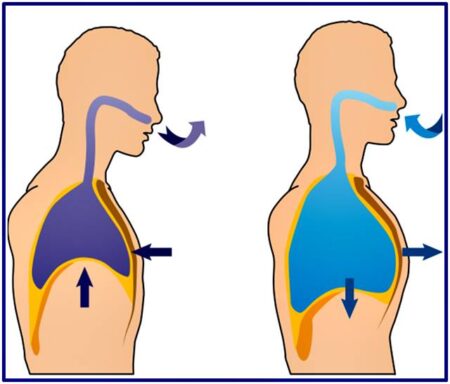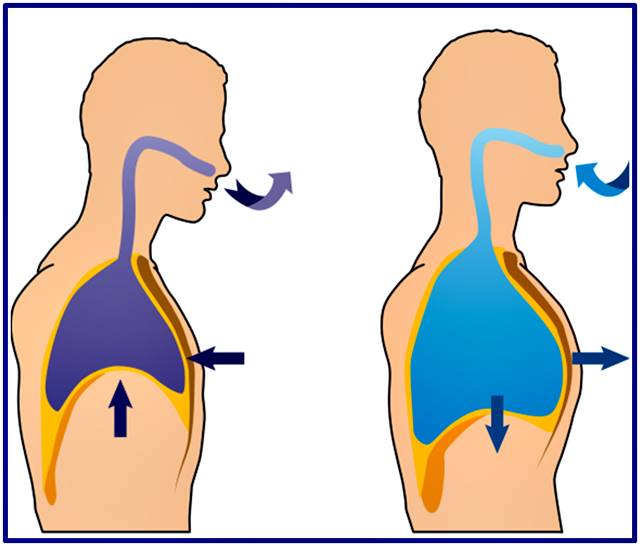 We explain what types of breathing exist and what internal and external breathing is like. Also, the respiration of plants.
We explain what types of breathing exist and what internal and external breathing is like. Also, the respiration of plants.
Hear
3 min. Reading
Respiration provides organisms with the oxygen necessary for their metabolism.
What is breathing?
Breathing is a vital process by which living beings exchange gases with the external environment or environment . In general, this process allows the entry of oxygen into the body and the expulsion of carbon dioxide into the environment.
This process is essential for the life of aerobic organisms, since it provides them with the necessary oxygen to keep their metabolisms running. However, it can be carried out through very different mechanisms depending on the complexity of each living being and the habitat in which it lives.
External respiration is the perceptible phase of a more complex physiological process, known as internal or cellular respiration. This process occurs in every cell in the body, where oxygen is used to oxidize simple sugars (such as glucose). In return, chemical energy is obtained in the form of Adenosine Triphosphate ( ATP ) molecules. However, some living things do not require oxygen to carry out cellular respiration.
Both processes (external respiration and cellular respiration) complement each other, but they should not be confused with each other. The types of respiration that exist for each of these processes are described below.
It can help you: Animal respiration
types of internal respiration
Aerobic respiration uses oxygen to oxidize sugars like glucose.
Cellular respiration or internal respiration is called a set of oxidation-reduction chemical reactions that occur inside cells and that allow organisms to obtain energy from a sugar (generally glucose). This energy is what they need to survive, grow and reproduce, that is, to carry out all vital functions.
Depending on whether the cells use molecular oxygen (O 2 ) or other chemical compounds in this metabolic process, there are two types of cellular respiration: one is aerobic respiration and the other is anaerobic respiration.
aerobic respiration
Aerobic or aerobic respiration is one that uses oxygen captured from the external environment to oxidize glucose or other similar sugars. More precisely, oxygen participates as the final acceptor of electrons in the last step of aerobic respiration.
Throughout this process, glucose is completely oxidized or degraded, giving water and carbon dioxide as by-products. The latter is discarded through external respiration.
Animals, plants , fungi , and most microorganisms ( protists and bacteria) undergo aerobic respiration. This is because this metabolic process has been favored throughout evolution.
Firstly, due to the availability of oxygen in the environment. And secondly, because it is more profitable than anaerobic respiration in energy terms (it produces more ATP molecules per glucose).
anaerobic respiration
Anaerobic or anaerobic respiration is that which does not use oxygen as a final electron acceptor . Instead nitrates, sulfates, carbon dioxide or other chemical compounds are used. Consequently, the by-products of this metabolism are also different (nitrites, sulphides, methane, etc.).
This metabolic process is not as efficient as aerobic respiration in terms of obtaining ATP molecules, because glucose is not completely oxidized.
Some bacteria and archaea that live in places with little or no oxygen have anaerobic respiration. There are also living beings that are facultative anaerobic, such as yeasts . In the absence of oxygen, these organisms can continue with the oxidation of glucose by other mechanisms, known as fermentation.
Types of external respiration
Adult amphibians combine pulmonary respiration with skin respiration.
External respiration (or simply respiration) is called the exchange of oxygen and carbon dioxide between a living being and the environment. In very small organisms, such as protists and some tiny animals, this occurs by diffusion.
In animals, four types of respiration are recognized according to the mechanism that allows the exchange of gases with the environment. Some are typical of animals in aquatic (or very humid) environments and others are typical of animals in terrestrial environments (although there are exceptions).
skin respiration
Worms exchange gases throughout their entire skin.
Cutaneous respiration is the one that occurs through the surface of the body, through which gases diffuse. It is typical of simple aquatic animals, such as porifera and cnidarians, and also of some terrestrial animals that inhabit very humid areas, such as flatworms and annelids.
This type of respiration also occurs in amphibians and in some reptiles and fish (such as water turtles and eels). In these animals, the skin is highly vascularized (that is, it has many ramifications for the bloodstream) for gas exchange between the blood and the outside to take place. Generally, this mechanism complements pulmonary or gill breathing.
gill breathing
Most fish have gills, although a few have lungs.
Gill breathing is that which occurs through the gills. These thin, filament-like organs are highly vascularized, allowing gas exchange between the circulating fluid (blood or hemolymph) and the surrounding water.
This respiratory system is the most efficient for life in the water. Some aquatic animals have external gills, such as starfish, marine worms, and aquatic amphibians (axolotls and tadpoles in the first life stage). Others have internal gills, such as fish, molluscs, and crustaceans .
tracheal breathing
The tracheas are the simplest and most effective respiratory system that terrestrial animals have.
Tracheal breathing is that which occurs through the tracheas. These are a set of tubes that branch throughout the body and that communicate with the exterior with each cell .
Oxygen-laden air enters the tracheal system through the spiracles, holes along the body. From there it spreads to every cell in the body. For its part, carbon dioxide takes the opposite path to the outside. This makes tracheal breathing independent of the circulatory system.
This type of respiration is typical of terrestrial arthropods , such as insects, myriapods (centipedes and millipedes) and some spiders. However, most arachnids have a particular structure, called the “book lung” , which is not related to the lung of vertebrate animals .
lung breathing
Birds have the most efficient lung respiration.
Pulmonary respiration is that which is carried out through the lungs. These organs are highly vascularized internal cavities where gas exchange between air and blood occurs . The entry and exit of air is done through muscular movements.
Once gas exchange has occurred in the lungs, the animal’s circulatory system is responsible for transporting oxygen to the cells of the body. In turn, it collects the carbon dioxide generated by the cells and carries it to the lungs.
The lungs are specialized organs for life on earth . They are present in all terrestrial vertebrate animals, with a greater or lesser degree of complexity. Some invertebrates also have lungs, such as many spiders and scorpions, some snails, and small crustaceans. However, these are not the same as those of vertebrates.
Do plants also breathe?
Plants are autotrophic organisms , that is, they are capable of producing their own food. They do this through a complex process called photosynthesis , in which they use water, carbon dioxide, and sunlight to synthesize chemical energy- rich organic sugars (such as glucose and starch).
In this process, plants consume carbon dioxide (CO 2 ) and release oxygen (O 2 ) to the environment, so it can be considered as the opposite and complementary mechanism to respiration.
However, plants also breathe, like any other living being. In this process, they break down manufactured sugars to generate energy (ATP molecules). And like all other aerobically respiring organisms, they use oxygen to oxidize glucose (or another simple sugar).
Although plants need sunlight to carry out photosynthesis, respiration can occur at any time of the day, even at night . For this they use part of the oxygen they produce in photosynthesis and also incorporate it through the stomata and lenticels. The opening and closing of these orifices regulate gas exchange and water loss.
